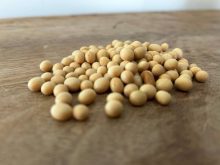MOSCOW, Dec 9 (Reuters) – Russia’s grain exports will remain at high levels in December, fuelled by a weaker rouble and adding to officials’ concerns about rising domestic prices, according to SovEcon, one of the leading Moscow-based agriculture consultancies.
Russia, one of the world’s largest wheat exporters, is exporting grains at a record pace this year after the second largest crop in its post-Soviet history of 104 million tonnes.
A 40 percent slump in the rouble against the U.S. dollar, caused by weak oil prices and Western sanctions over the Ukraine crisis, is making Russia’s exports more competitive.
Read Also

U.S. grains: Soybean prices rise as China-U.S. truce assessed
Chicago soybean prices rose on Wednesday, recovering some of the previous session’s losses, as Beijing’s confirmation that it was cutting tariffs on U.S. farm goods put attention back on a trade truce between the countries.
But the rise in exports, as well as a Russian ban on certain food imports, is causing domestic grain prices to rise.
“The grain balance (of supply and demand), which was quite comfortable thanks to a large grain crop, is becoming more strained and is causing a growing concern for the government due to domestic grain prices’ growth,” SovEcon said in a report.
The government may consider imposing a floating tariff on grain exports as a measure of last resort in 2015, an agriculture ministry official said in late November.
A day later, Russia’s phytosanitary regulator said it could introduce new regulations on grain exports, fuelling speculation they could be a first step in export restrictions.
However, today Interfax news agency quoted deputy prime minister Arkady Dvorkovich as saying the government is not discussing grain export restrictions.
Russia will export between 2.9 million and 3.0 million tonnes of grains in December, down from 3.14 million tonnes in November, according to SovEcon. Its estimate includes pulses and flour.
For the first half of the 2014-15 marketing year, which started on July 1, exports will reach 21 million tonnes, exceeding the previous record set in the first half of 2011-12 by 2.5 million tonnes.
Livestock feeders are adding pressure on the government because their costs are rising. Also fall seeded grains were under stress going tinto the winter, raising the risk of a crop decline in 2015, SovEcon said.
Government grain stocks, meanwhile, are at a low level of 1.75 million tonnes and a program to replenish them has stalled, meaning it will have limited ability to respond if the crop falls significantly in 2015.
The market, however, is likely to stabilise if grain exports exceed 10-11 million tonnes in January-June 2015 and the rouble stops falling, causing a sharp increase in domestic prices and thus making exports less attractive, SovEcon said.














